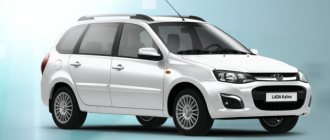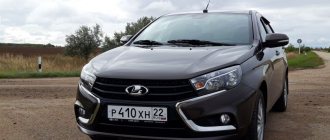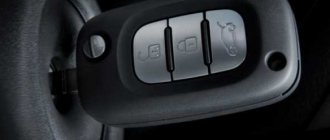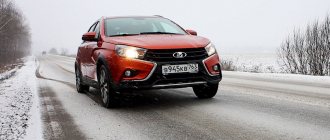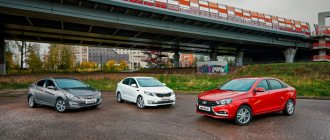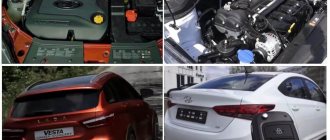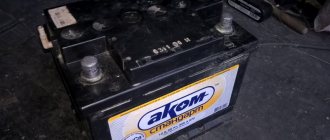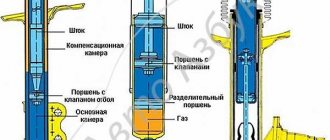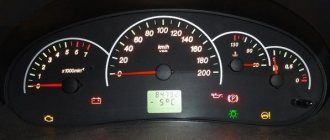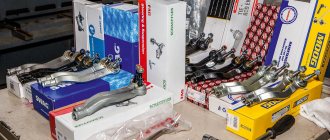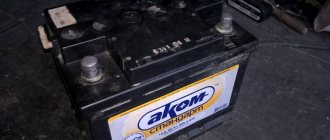The process of developing and building a modern car, including the Lada Vesta, is closely related to calculations of the structural strength of the body and modeling the efficiency of systems responsible for safety. For a correct assessment of the final result, such calculations are not enough. Life forces manufacturers to test their new products. There is a crash test for this purpose.
This development of events did not bypass the progressive model of domestic origin Lada Vesta. A ready-to-use sample was tested.
Crash test result from Autoreview: LADA Vesta is a safety champion
We can speak with confidence about the safety of the Lada Vesta after the Lada Vesta passed a crash test conducted by the Atoreview publication.
According to the results of this crash test, the new sedan received a high score of 4 ARCAP stars.
Now the car can be confidently called the safest representative on the Russian market.
As a result of the crash test, Vesta's cage did not undergo deformation. The doorway decreased by only 4 mm. Minor changes were felt in the steering column and pedals. Belts equipped with pyrotechnic tensioners and airbags worked flawlessly.
Mikhail Podorozhansky, editor-in-chief of Autoreview and head of an independent crash test, said that the Lada Vesta was made taking into account all safety requirements. The high quality of parts and connections is admirable. In comparison with other domestic cars, the new sedan has achieved maximum results that are not yet available to its analogues.
The President of AvtoVAZ thanked the representatives of Autoreview for the high professionalism with which the crash test was carried out. However, Bo Andersson said that AvtoVAZ expected a similar result. Over the previous two years, Lada Vesta passed 150 virtual and more than 30 real crash tests. The latest test only confirmed earlier studies. Now we can say with confidence that the LADA Vesta sedan fully meets international safety standards.
The car, which passed the tests, was purchased by the Autoreview publication in December last year in Perm. This sedan corresponds to the “Comfort” package, but the safety system is similar to the minimum “Classic” package.
The crash test conducted by ARCAP involves an oblique frontal impact of the car on an obstacle at a speed of 64 km per hour. LADA Vesta became the 35th car included in this program.
Purpose and features
A crash test is a test of a car in an artificial emergency collision with an obstacle. The procedure involves creating an artificial accident to more accurately identify possible damage, as well as the degree of safety of people in the vehicle. Beginning in 1965, special dummies began to be used in crash tests. Before this, animals, real human corpses, were used for these purposes.
Dozens of different sensors are used to measure the level of damage from collisions with obstacles. Such tests are carried out in most cases before the vehicle is put into mass production. Frontal, side and rear impacts are used to determine the level of damage.
The result of the crash test is an assessment of potential damage to the head and body of the driver and passengers. During the tests, the reliability, strength, and safety of body and attachment parts are revealed.
Basic crash test techniques
In its modern form, emergency tests are carried out mainly using two objective systems. This is the European Euro NCAP scenario and the American NHTSA test. Euro NCAP consists of four main stages:
- A car collides with an obstacle frontally at a speed of 64 km/h.
- There is an impact from the side - a trolley weighing 950 kg enters the vehicle.
- A car collides with a metal pole with a diameter of 254 mm at a speed of 29 km/h.
- The safety of a vehicle for pedestrians is tested by colliding with a dummy at a speed of 40 km/h.
Additionally, child safety can be studied. To do this, the child restraint system of a specific car model is tested. Based on the results of the crash test, a rating is given according to a 16-point system - the sum is the sum of all stages performed.
The American crash test methodology is somewhat different from the European one. In this scenario, the car does not hit an obstacle, but a special durable structure that is not subject to deformation, at a speed of 56 km/h. Side impact is tested at a speed of 61 km/h, with a bogie weight of 1350 kg. Side impact tests are performed on both sides of the vehicle.
In the USA, a series of tests by the Institute of Safety for companies involved in insurance activities (IIHS) is additionally practiced. In general, this test follows the Euro NCAP stages, but the frontal impact test involves only a driver dummy, and the side impact test is carried out using a 1.5 tonne bogie.
Rating system
After summing up the results of the crash test, experts give ratings based on the points scored, there are four in total:
- Badly;
- weak;
- satisfactorily;
- Fine.
In this case, points from 1 to 5 or stars can be assigned. In this regard, everything is simple - the more stars you collect, the higher the security. A “good” rating indicates a high level of vehicle safety - in the event of an emergency, the driver and passengers receive minimal damage or do not receive serious injuries at all. A “poor” rating indicates a low level of security. In an accident, the risk of critical injury to the driver and passengers is extremely high, including death.
For a car to be considered safe for use on public roads, it must receive a crash test rating of "good" or three stars in the European test scenario.
Frontal impact crash test
Frontal or frontal impact is the main type of test. In a real situation, this is the most traumatic blow. In a frontal collision, the danger is represented not only by injury to the driver and passengers, but also by the entry of foreign objects from outside into the passenger compartment. Therefore, a frontal impact should be as less serious as possible for the car in terms of deformation and damage.
In most cases, according to the EU system, the car accelerates to 65 km/h and crashes into a wall. In this case, a head-on collision of a vehicle with an oncoming car is simulated. Statistically, most modern cars pass this test well. Only 20% of cars are rated negatively by this criterion.
If an automaker receives a good frontal impact rating, it can conduct similar crash tests on its own vehicles. From time to time, independent organizations have the right to conduct unscheduled tests.
Side impact test
The second most important crash test is the side impact test. To achieve this, all test systems use a special trolley of varying weights, which impacts the side of the vehicle. The impact should be on the driver's and rear passenger's side doors. The acceleration speed is 50 km/h, simulating a collision with a light truck.
The test uses a dummy of a driver and a teenager, which is located directly behind the driver's seat. Recently, a female mannequin has been used for objective reasons. The fact is that a female driver most often sits closer to the steering wheel; during an accident, her head hits the center of the side window. This position is dangerous - the risk of critical head injury is very high.
Hit to the rear
Testing the rear of the vehicle is no less important than the front. In such tests, attention is paid to head restraints and control of their height for people of different heights. During the stern crash test, the driver's seat is installed on special rails to allow movement on them, a dummy made of flexible materials is seated in it and fastened with a seat belt.
At a speed of 35 km/h, a rear impact is simulated. At the same time, the speed of operation of the seat belt mechanism and the speed of firing the airbags are determined, and the operation of the anti-lock brake system is also checked. Modern cars are increasingly equipped with special safety equipment that uses emergency braking, dodging obstacles, monitoring road markings, and maintaining straight-line traffic. You will not find such systems on domestically produced cars, but technical capabilities do not stand still and, perhaps, in the near future these systems will save lives on Russian cars.
Crash test for pedestrian safety
Recently, another stage of testing has been used, which involves checking the degree of safety of pedestrians in a collision with a car. The main objective of the test is to make sure that in an accident involving a pedestrian, the level of injury risk for the latter is the lowest. Not forgetting about this crash test, many global automakers take this into account when developing or upgrading the body.
For this stage, a special technique is used - the pedestrian should not receive critical or fatal damage upon impact. According to statistics, in most cases, a pedestrian in an accident receives serious injuries due to an impact with the hood and windshield. To minimize the risk of damage, some automakers equip the front part of the car with special hydraulic chucks. In the event of a collision with a pedestrian, these devices raise the hood slightly - the impact is softened, and the likelihood of hitting the head on the body or windshield is minimized. The deformation zones of body parts when colliding with a person are constantly being improved. All these stages must be taken into account before issuing the final grade. If the car manufacturer expects to receive maximum points, then when producing the vehicle, all of the listed features must be taken into account.
Ignoring safety points will inevitably lead to lower scores in independent crash tests. They are much stricter than the tests conducted by the automaker, during which concessions are allowed, deliberately inflating the final test scores.
About crash tests
It is worth noting that the presented video of the Lada Vesta crash test cannot convey the entire path traveled by AvtoVAZ engineers and designers in order for their new brainchild to become worthy of the title “the best car of the concern.” To an inexperienced viewer, it may seem that a remote-controlled car is simply being accelerated and allowed to crash into a solid structure - but this is not entirely true.
Each crash test of the new Lada Vesta is a carefully planned event, verified down to the smallest details. The measures taken should provide decent results in terms of the level of safety of the driver and passengers inside the crashed car. The speed of movement is carefully checked - the car must withstand impacts without exceeding the speed, trajectory, reverse acceleration of the braking distance on different types of surfaces - and this is just a short list of all the tests. It is impossible to understand from the photo of the crash test how labor-intensive this process is - and at this time the concern produced more than half a thousand cars exclusively for these purposes.
Crash test results
People who were looking forward to the release of the next new AvtoVAZ product can breathe a sigh of relief. The safety characteristics of the Lada Vesta are practically in no way inferior to their foreign counterparts, which can already be considered a decent result.
During the checks, it was determined whether the driver of the car could avoid serious injuries in a collision in the city at a maximum permissible speed of 60 km/h. This crash test of the Lada Vesta showed the maximum number of stars - the car more than confidently protected both the driver and passengers with its body. The driver's airbag was also tested flawlessly - it opens exactly at the right moment and protects the driver from hitting the steering wheel with his face.
Dozens of other checks were also carried out. The initial crash test rating was lower than expected, but after some adjustments were made to the manual drive axle locking system, the vehicle's safety level increased above 90% (which is already comparable to the safety level of cars from the world's leading manufacturers).
For comparison
Volkswagen Polo. The hood, both headlights, bumper, crossbar with crushed elements, plastic radiator mounting box and air duct are damaged.
Hyundai Solaris. The bumper was cracked, the hood and fender were slightly dented, the headlight and fog lamp housing were destroyed, the front beam and the end of the left side member were damaged
Chevrolet Cobalt. The bumper cover is torn, both headlights are damaged, the front panel, crossbar, hood and left fender are deformed
Peugeot 408. The crossbar and replacement mounts of the left headlight are damaged, the bumper trim is slightly damaged
Renault Sandero. The front beam, engine subframe, front part of the left side member, top panel, front left fender and engine compartment mudguard were deformed. The left headlight is broken, the edge of the hood is dented, the front bumper is torn, the radiator mount is broken
Lada Granta. The radiator frame is crushed and torn, the hood, headlight, both wings, and spar are damaged.
Nissan Almera. The bumper lining was damaged, both headlights were damaged, the front panel, crossbar, side member, subframe, hood and left fender were deformed.
Skoda Rapid. The edge of the hood is jammed, the headlight, bumper trim, crossbar with crushed elements, radiator mounting screen, left fender, fog lamp are damaged.
Geely Emgrand. The hood, fender, amplifier and bumper trim, headlight, and transmission radiator were damaged. The front body panel, side member and mudguard of the engine compartment were deformed
Other tests
Naturally, crash tests are not the only tests for the Lada Vesta. In addition to the car’s resistance to frontal and side collisions and the operation of protective systems, the electronics embedded in the car’s interior and the chassis of the basic configuration were also tested.
Indeed: the results of the Lada Vesta crash test did not show the presence of deficiencies in the car's suspension system (which, however, were eliminated after unsatisfactory test results). Also, the crash test of the Lada Vesta could not reveal the presence of defects in the operation of the exchange rate stabilization system - it continued to limit the speed of the car for some time after the final exit from the turn.
For all other points, for testing of which almost half a thousand brand new cars, fresh from the assembly shop, were allocated, the tests of the Lada Vesta showed quite satisfactory results. Today, according to the general director of AvtoVAZ, the car’s safety level is 95% according to the world quality standard. Considering the rather low cost of Vesta compared to foreign cars of the same vintage, this level of quality of the new generation of domestic cars threatens to push both Western and Japanese cars out of the Russian car market.
More details about Lada “Vesta” cars
How AVTOVAZ reacted to the test results
The engineers were really puzzled by the results; they decided to buy back the car that was broken during testing in order to examine it, since there was a possibility of defects during the assembly process. However, this option was not confirmed. Then they carried out computer modeling and compared the test results at the plant site and the result of the Autoreview test. It turned out that the reason for this behavior of the car in a collision was ballast. There is an algorithm for preparing a car for testing.
| Weight on front seats (dummy weight) | 88 kg each |
| Indicator of tank fullness with gasoline (gasoline is replaced with water) | 90 % |
| Ballast weight on the rear seat | 32 kg |
| Weight in the luggage compartment required for testing the equipment | 36 kg |
When testing was carried out at the factory, 2 child seats and 2 child dummies were installed on the rear sofa, but in the external test they used metal ingots that were screwed to the floors. The weight of each ingot is 20 kg. Permission to use this approach is given by Euro NCAP standards only when there is a guarantee that it will not affect the test results. A mathematical model was created, and engineers found that the use of two ingots, each weighing twenty kilograms, affected the load on the reinforcements and welds, increasing it by 20%. That's why the floors were deformed.
After this fact was clarified, 2 similar procedures were carried out using metal ingots, and the result was consistent with that. What did the representatives of Autoreview receive? But test 3 was carried out with child dummies, and it gave excellent results. Here we note the excellent work of the belts, the absence of folds in the floor, the metal and welding firmly withstand impact. It turns out that if 2 child dummies had been seated in the car, it would have received almost 15 points instead of 11.7. However, the test results prompted the designers to seal the floors, and they succeeded.
